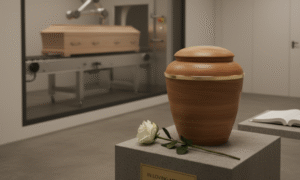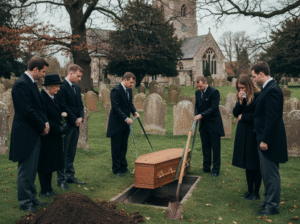Honouring someone’s life does not end at the funeral. Many families choose to create a memorial or tribute that reflects their loved one’s values, culture, and personality. In the UK there are a wide range of options, from traditional headstones to digital remembrance pages, each with its own legal and practical considerations. This guide explains the main types of memorials and tributes available, how they are arranged, and the factors to keep in mind.
1. Headstones and Grave Markers
Headstones remain the most familiar form of remembrance in Britain. They can be made from granite, marble, slate, or other natural stone, with designs ranging from simple inscriptions to carved motifs or photographs.
Before commissioning a stone, check the regulations of the cemetery or churchyard: many have rules on size, colour, materials, and wording. It is also worth discussing maintenance, as some finishes weather differently over time.
2. Cremation Memorials
Cremated remains may be placed in a dedicated memorial space. Popular choices include columbarium niches, above-ground vaults, and inscribed tablets in a garden of remembrance.
Families sometimes scatter a portion of the ashes in a meaningful location, while retaining the rest in a decorative urn at home. When scattering on public land or water, always confirm whether permission is required and avoid environmentally sensitive areas.
3. Woodland and Natural Burials
A growing number of people prefer memorials that blend with the landscape. Woodland burial grounds allow a tree or native shrub to be planted over the grave, often marked by a modest plaque rather than a headstone.
These sites encourage long-term conservation, with paths kept natural and minimal disturbance to wildlife. They can be a fitting choice for anyone who valued sustainability or quiet surroundings.
4. Memorial Benches and Plaques
Many parks, cemeteries, and coastal paths permit memorial benches or plaques. Councils typically manage applications, charging a fee for the seat and maintenance. The inscription can be personal while remaining respectful to other visitors.
Benches and plaques work well for people who enjoyed the outdoors or a particular view, offering family and friends a place to pause and remember.
5. Digital and Community Tributes
Online memorial pages, charity fundraisers, or video compilations provide an accessible way for people to share memories, especially when relatives live far apart. Some platforms allow long-term hosting so the tribute remains available for anniversaries and special dates.
Community events, such as planting days or remembrance walks, also create opportunities to honour someone’s contribution to local life. These can be particularly meaningful where the person was involved in clubs, faith groups, or volunteering.
6. Personal Items and Home Memorials
Smaller keepsakes—framed photographs, jewellery containing a small amount of ashes, or engraved candles—allow remembrance within the home. These items can complement larger memorials or stand alone for families who prefer a private expression of grief.
It is advisable to use reputable suppliers, particularly for jewellery or glass pieces containing cremated remains, as specialist processes are needed to protect the material.
7. Legal and Practical Considerations
Whatever form of tribute is chosen, there are usually permissions and timeframes to consider. Most burial grounds ask families to wait several months before placing a headstone, allowing the soil to settle. For memorial benches or trees on public land, written approval from the authority is essential.
When arranging anything permanent, keep copies of agreements and receipts. They will help if future maintenance or restoration is needed.
8. Choosing the Right Memorial
Selecting a memorial is both an emotional and practical decision. Take time to reflect on what best represents the person’s character, beliefs, and the way they lived. Budget, location, and long-term upkeep should all be part of the discussion.
A thoughtful choice can provide a lasting focus for remembrance, giving comfort to family and friends for years to come.
How Gooding Funeral Services Can Support You
At Gooding Funeral Services, we guide families through every stage of arranging memorials and tributes, from liaising with stonemasons to advising on woodland burials or digital remembrance pages. Our team ensures all legal and local requirements are met, so you can focus on honouring your loved one’s memory with confidence.
Pages You Might Like:
Funeral directors UK, Funeral services UK, Funeral Services in Leeds, Funeral directors Leeds, Funeral Directors in Bradford, Funeral Directors Bradford, Funeral Directors Manchester, Funeral Directors Huddersfield, Funeral Services in Doncaster, Asian Funeral Services, Hindu Funeral Services, Sikh Funeral Services, Caribbean Funeral Service










